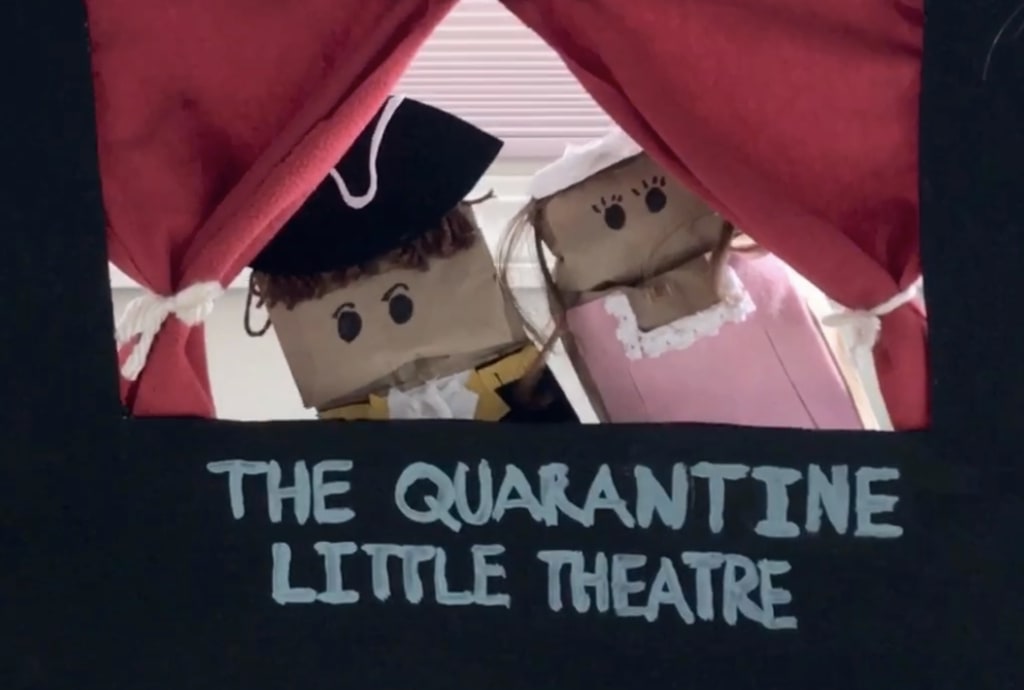
December 1777. The bloodied, bedraggled Continental Army limps barefoot into freezing Valley Forge. Morale is at an all-time low.
A string of defeats hangs over the improvised camp. They have failed to keep the British from occupying their capital city, Philadelphia. Idleness only magnifies the challenges that lie ahead. Undisciplined, unstructured, and uninspired, the Continental Army hangs by a thread.
General George Washington's back is against the wall. Staring out across the icy, muddy fields of Valley Forge, he faces his greatest challenge. In the face of unprecedented adversity, how will he keep the Continental Army an army...and find a way forward?
March 2020. Quarantine. Teachers and students across the United States mark a hasty, panicked retreat from their classrooms. The unknown effects of COVID-19 mandate immediate withdrawal from school campuses. Every campus, public or private, big or small, is to be abandoned.
In a flash, teachers scrounge together whatever resources they can get their hands on. The new operational term: something called "Distance Learning." No one knows how long the quarantine will last. But teachers are told to plan for an indefinite period of at-home learning.
As a fifth-grade teacher that loves Revolutionary War history, my mind immediately flashed to Washington's retreat to Valley Forge.
Supplies were scarce. Morale was low. During pandemic times, students needed the structure and engagement of the classroom like never before. As a teacher, I aspired to provide a vivid, hands-on, tactile, in-class experience. But in 24 hours, all of my time-tested teaching strategies were suddenly outmoded.
So like Washington, I found myself facing a miniaturized version of the challenge of Winter 1777. How to hold together a class when faced with unprecedented challenges, keep students inspired, and find a new way forward?
For sixteen years, I taught countless elementary school students about the moments that shape American history. Some 240-odd years later, I was going to have to adopt some revolutionary thinking of my own.
For the moment, the immediacy of in-person interaction was gone. Yet, I felt a calling to engage my "troops." To pivot them away from the demoralizing boredom of learning in isolation. I thought back to the feel and texture of learning that captivated me when I was a child.
Back then, I was so inspired to teach that the eleven-year-old me created her own handmade classroom for five-and-six year-olds. Once again? It was time to get scrappy. To improvise.
To get crafty.
It was time to dust off a toolkit, long-ago relegated to a closet shelf. And bring that crafted, textured feel back to the forefront of my teaching.
For the whole spring of 2020, when I wasn't teaching live synchronous lessons? I worked with my hands. My long dining room table overflowed with poster board, paper lunch bags, construction paper, felt, wooden peg dolls, hot glue, and infinite mixtures of paint.
The heart of my operation: several pairs of scissors. I had different scissors for different needs, from cutting dense, thick stacks of felt to impossibly delicate snips of lace - where one false move could derail hours of work.
I built. I planned, improvised, tore down, and built again. My detached virtual lessons became must-see handcrafted presentations. Students would tune in just to see what fresh boldness Mrs. Cregan had planned for the day.
I was invigorated in a way I hadn't been since my earliest days of teaching—the constant need to motivate and inspire kept me motivated and inspired.
At the same time, my new style transfixed and delighted my students. Now, when we finished our assigned curriculum, we found ourselves having too much fun to stop.
To cap off a school year unlike any other, I wanted a big finish—a means to send my students into their summer with a fresh supply of Revolutionary spirit.
Thankfully, I didn't have to search long for inspiration: Hamilton. The groundbreaking musical sparked a new Revolutionary passion in my students. Many of us scored tickets for Hamilton's second Los Angeles run, only to find it canceled by the pandemic.
If my students couldn't see Hamilton at the Pantages Theatre? I would bring Hamilton remotely to them.
Finally, I had a definitive use for the pile of discarded Amazon boxes I had saved in my driveway. My goal: cut and construct a grand "The Little Quarantine Theatre." Then stage a live webcast of Hamilton with handmade puppets, to be performed by myself and my two newly-drafted children.
My array of scissors was about to put in some serious overtime.
My scissors sliced up the cardboard that formed the heart of my theatre's foundation. Cut up my daughter's recently-outgrown red dress into miniaturized stage curtains. Sheared an old bedsheet to reconstruct Corwallis' white flag of surrender at the Battle of Yorktown.
I took particular pleasure in meticulously recreating every single character in Hamilton's company. My scissors attacked every remaining scrap of felt in the house to form the identifying features of my handmade puppet cast.
I built both a young, robust Act 1 Hamilton and his doomed, world-weary Act 2 incarnation. In the name of fairness? Feckless, villainous Aaron Burr received the same two-act treatment. The Schuyler sisters were adorned with hair snipped from my daughter's less-cherished dolls. King George III was a vision in gold and white felt, in my best homage to his iconically tortured portrait.
Finally, "The Little Quarantine Theatre" was ready for its grand debut. My husband set up a shot via his iPhone's camera app. He hit "play" on the soundtrack on my iPhone. Hamilton's opening bars crashed in, spurring Lin-Manuel Miranda's drama to life.
And my children and I got down to some serious puppetry.
The Little Quarantine Theatre's one-and-only performance was a rousing success. My students sailed off into their summers with Hamilton's timeless, inspirational lesson etched in their minds.
COVID-19 and the British didn't beat us. It just made us craftier.
They left their school year energized and fortified for whatever battles lay ahead. Marching forward toward a somewhat uncertain future...but with a little more creativity, a little more passion, and a reservoir of confidence. The confidence that when necessary, we can roll up our sleeves, grab the needed tools, and re-shape the outcome.
I was left wondering: was this how Washington felt in Spring 1778? When Washington's restored, re-trained, revitalized Continental Army marched out of Valley Forge and whipped the British at the Battle of Monmouth?
I felt a rush of Revolutionary spirit. And a fresh understanding.
Across history, whether on a battlefield, or in the classroom...when pressed against incalculable odds, the American character will always find a way to move forward. To improvise. To get creative. To get scrappy.
With a handy pair of scissors standing by.
About the Creator
Enjoyed the story? Support the Creator.
Subscribe for free to receive all their stories in your feed. You could also pledge your support or give them a one-off tip, letting them know you appreciate their work.






Comments
There are no comments for this story
Be the first to respond and start the conversation.